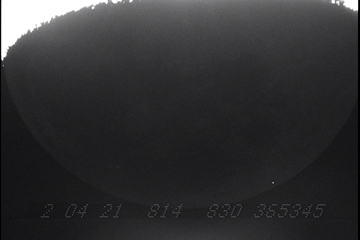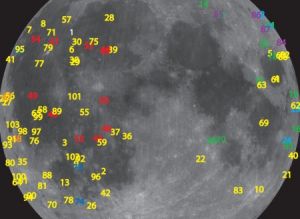In the past two and a half years, the Moon has taken a real beating. NASA astronomers have observed over a hundred explosions on the Moon during this time, caused by meteoroids both large and small, slamming into the Moon at speeds of up to 160,000 miles per hour (257,495 kilometers per hour).
The Moon gets pelted constantly – over a metric ton of material falls on the Moon every day! Most impacts are too dim to see with the naked eye because they are small micrometeorites. The rate of the flashes from larger impacts increases dramatically – up to an impact every hour – during meteor showers such as the Perseids and Quadrantids. The sporadic impacts account for twice as many observable events as compared to meteor shower impacts.
If you were standing on the Moon, you wouldn’t see these impacts as “shooting stars,” though, since there is no atmosphere in which they can burn up. The explosion is also not something like one would see here on Earth, as the absence of oxygen doesn’t allow for any combustion. The kinetic energy of the impact heats up the rocks on the surface to the point where they become molten, and glow for a short period after the impact.
 Pictured left is the flash from a confirmed impact on March 13th, 2008, as captured by amateur astronomer George Varros. The small white point in the bottom right of the picture is where the impact occurred. He has an animation of the event on his site.
Pictured left is the flash from a confirmed impact on March 13th, 2008, as captured by amateur astronomer George Varros. The small white point in the bottom right of the picture is where the impact occurred. He has an animation of the event on his site.
Monitoring the number of impacts on the Moon is important for future missions to visit our smaller neighbor, as well as for the eventual establishment of a Moon base. It will be important to know when astronauts should take cover from potential strikes during peak periods of impacts. After all, even a small meteoroid traveling between 4500 mph (7,242 kph) and 160,000 mph (257, 495) could do a lot of damage to a space suit or lunar base. A typical blast that can be seen with a backyard telescope from Earth is equivalent to a few hundred pounds of TNT. I know I wouldn’t want to go for a Moon walk during a meteor shower…
NASA has been observing lunar impacts with one 14-inch (36 cm) telescope and one 20-inch (51 cm) located at the Marshall Space Flight Center in Alabama, and one 14-inch telescope located in Georgia.
But it’s not just NASA that can see these lunar fireworks: NASA’s Meteoroid Environment Office has called for amateur astronomers to help in recording and confirming these flashes. If you have a lot of patience, a telescope and a way to record the flashes, check out their site to get started.


Goodness me. This is sure to get the 2012 doomsayers going…
Tell me exactly why it is a bad idea to put a base on the moon again?
tacitus,
well said.
“Tell me exactly why it is a bad idea to put a base on the moon again?”
That’s what Heinlein said.
It makes no sense to put a base ON the moon, where meteroid impacts can shred your dome and you need an excessive amount of power to air-condition the place against the 28 days that the sun will be in the sky.
Only logical thing to do is to stick your base IN the moon where it’s immune to those problems.
En los últimos dos años y medio a la Luna le dan dado una buena golpiza. Los astrónomos de la NASA han observado más de cien explosiones en Luna durante este perÃodo, causadas por meteoritos de tamaño variable que caen a velocidades cercanas a los 250 mil kilómetros por hora […] Fuente: Nicholos Wethington para Universe Today, y NASA.
“speeds in excess of up to 160,000 miles per hour (257,495 kilometers per hour).”
This sentence doesn’t make sense to me.
Which is it, “in excess of” or “up to”.
The first means more than 160,000 miles per hour and the second means less than 160,000 miles per hour.
IN ORDER TO PUT A BASE IN THE MOON WE HAVE TO ESTABLISH AN OUTPOST ON THE MOON SO CONSTRUCTION AND EXCAVATION CAN TAKE PLACE.
WE’D BETTER COME UP WITH SOME WAY TO DO LOTS OF SOIL MOVING OR HUMANS WILL BE IN PERIL.
MAYBE THERE IS A SUBSTANCE WE COULD BRING TO THE MOON, MIX WITH MOON SOIL WHICH WOULD CAUSE THE MOONSOIL TO HARDEN. WE COULD SHOTCRETE THE MIXTURE OVER OUR BLADDER HABITATIONS TO FORM CAVES
@ Lotusface: I agree with you. A moon base is inevitable in the near future, however, in order to construct a permanent, meteoroid-strike-free base underneath the lunar surface, a temporary lunar base is necessary. These permanent bases will, in fact, be integrated into the lunar terrain eventually — eg. using rilles, craters etc., — and can be constructed using the lunar soil with hardners and the, hopefully, water-ice resources available in the pole regions. These water-ice resources have yet to be fully confirmed (aka: Clementine and Lunar Prospector results), and they will very much determine the quickness in time of future space exploration to other planets like Mars. It will take a lot of time and resources initially to construct the strike-free habitats, but “small steps” at a time have to be envisioned if we are to succeed.
John — http://www.moonposter.ie
Looking at the image, perhaps we should camp down in the Sea of Tranquility or Serenity, looks like we’d be safer there 😉 I think we can forget about the West limb, peppered with meteorites out there!
Nice article Nick, makes me want to do some lunar astronomy now 🙂
Cheers, Ian
MothyJohn,
I changed the phrasing to make it clearer. I’d meant “up to”, but during the writing something else snuck out of my brain and onto the page in addition. Thanks for keeping me honest!
~Nick
Great! Now I won’t think I am seeing things when I see a small momentary point of light on the dark areas of the moon! AND now I have something else to look forword to when I observe/photo the moon…Thanks for the article!!!
dave
Dave,
You are not alone. I was looking at the crater Eratosthenes with my XT-12 using 18mm lenses in my binoviewer along with the shorty barlow and saw gases belching from there about 9 months ago. I have even seen new shadows in Theophilis that weren’t there before, stretching across the whole crater during crescent phase.
Why not send one of those tunnell digging machines they use to build subway tunnells?
It seems to me that it should be possible to dig out dozens if not hundreds of miles of tunnells before the first astronaughts step foot on the Moon.